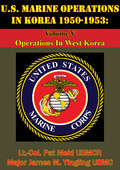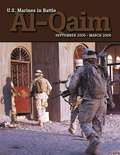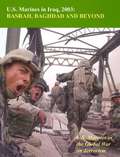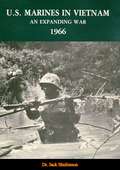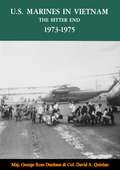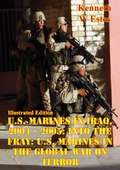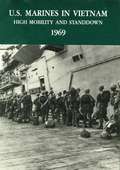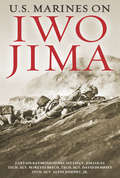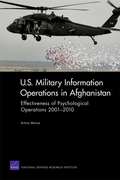- Table View
- List View
U.S. Marine Operations In Korea 1950-1953: Volume V - Operations In West Korea [Illustrated Edition] (U.S. Marine Operations In Korea 1950-1953 #5)
by Lt.-Col. Pat Meid USMCR Major James M. Yingling USMCIncludes over 50 photos and 35 maps.THIS IS THE CONCLUDING VOLUME of a five-part series dealing with operations of United States Marines in Korea between 2 August 1950 and 27 July 1953. Volume V provides a definitive account of operations of the 1st Marine Division and the 1st Marine Aircraft Wing during 1952-1953, the final phase of the Korean War. At this time the division operated under Eighth U.S. Army in Korea (EUSAK) control in the far western sector of I Corps, while Marine aviators and squadrons functioned as a component of the Fifth Air Force (FAF)."MENTION THE KOREAN WAR and almost immediately it evokes the memory of Marines at Pusan, Inchon, Chosin Reservoir, or the Punchbowl. Americans everywhere remember the Marine Corps' combat readiness, courage, and military skills that were largely responsible for the success of these early operations in 1950-1951. Not as dramatic or well-known are the important accomplishments of the Marines during the latter part of the Korean War.In March 1952 the 1st Marine Division redeployed from the East-Central front to West Korea. This new sector, nearly 35 miles in length, anchored the far western end of I Corps and was one of the most critical of the entire Eighth Army line. Here the Marines blocked the enemy's goal of penetrating to Seoul, the South Korean capital. Northwest of the Marine Main Line of Resistance, less than five miles distant, lay Panmunjom, site of the sporadic truce negotiations.Whatever guise the enemy of the United States chooses or wherever he draws his battleline, he will find the Marines with their age-old answer. Today, as in the Korean era, Marine Corps readiness and professionalism are prepared to apply the cutting edge against any threat of American security."-Gen. Chapman
U.S. Marines In Afghanistan, 2001-2002: From The Sea
by Colonel Nathan S. LowreyIncludes more than 100 maps, plans and illustrations."This monograph is more than the story of Marine expeditionary operations in Afghanistan. It describes who our nation's enemies are; how America became involved in the Global War on Terrorism; and how the Marine Corps struggled to acquire a major role in Operation Enduring Freedom, as well as the actions of Marines and sailors who helped prosecute the air and ground campaigns against Taliban and al-Qaeda forces."-- Dr. Charles P. Neimeyer, Director of Marine Corps History
U.S. Marines In Battle: Al-Qaim, September 2005-March 2006 [Illustrated Edition]
by Dr Nicholas J. SchlosserIncludes more than 30 photos, maps and plansThis study examines a counterinsurgency campaign conducted during the Iraq War between the fall of 2005 and spring of 2006 in the district of al-Qaim on the Syrian border. In many ways, the struggle to clear and hold the district marked a turning point for the U.S. Marines fighting to bring security and stability to al-Anbar Province. The tactics and procedures utilized by the Marines of Regimental Combat Team 2 as well as its numerous supporting units served as a model for future operations in 2006 and 2007.The Iraq War began in 2003 with a lightning quick assault by Coalition forces that toppled Saddam Hussein's Ba'athist regime within a matter of weeks. During the months immediately following the overthrow of the old regime, a lack of adequate security forces and indecision among policy makers rapidly led to a collapse of order and stability. By the summer a broad insurgency conducted by former regime loyalists, criminals, and Islamic fundamentalist fighters had broken out against the U.S. occupation of the country. The U.S.' initial goal of creating an independent, democratic government was superseded by the more basic and pressing need to establish a secure and stable Iraqi state.The lack of a unified approach to U.S. strategy in Iraq meant that it often fell to the commanders of smaller units (brigades, regiments, and battalions) to devise an effective means for defeating the insurgency in their particular areas of responsibility. It was in this type of operating environment that the commander of Regimental Combat Team 2, Colonel Stephen W. Davis, and one of his battalion commanders, Lieutenant Colonel Julian D. Alford of 3d Battalion, 6th Marines, undertook a concerted campaign to clear and secure al-Qaim District in western Iraq.
U.S. Marines In Battle: An-Najaf, August 2004. [Illustrated Edition]
by Francis X. KozlowskiIncludes 3 maps and 35 illustrations.The city of an-Najaf, Iraq, is a provincial and market center located on the western branch of the Euphrates River approximately 100 miles south of Baghdad....This is a "battle study" written purposely from the perspective of the Marines, soldiers, and sailors who fought at an-Najaf in Aug. 2004...The Americans deployed to al-Anbar and an-Najaf Provinces, faced a variety of threats as Iraq attempted to again govern itself. Threats were from disparate sources, including Sunni fighters in Fallujah and Shi'a fighters in Najaf. This complexity of threats did not lend itself to easy solutions. In March 2004, Lieutenant General James T. Conway's I Marine Expeditionary Force was faced with an outbreak of Sunni insurgency in Fallujah. At the same time, a Shi'a uprising took place across Iraq, including Baghdad, Najaf, an-Nasiriyah, al-Kut, al-Amarah, and Kirkuk. The fighting spread to Karbala, Hillah, and Basrah with attacks on Iraqi and Coalition outposts. This fighting dropped off in June with the establishment of the Iraqi Interim Government of Prime Minister Ayad Allawi, but the menace of further violence remained.The Multi-National Force-Iraq, under General George W. Casey Jr., USA, felt that before the Iraqis could be responsible for security in each province, the centers of violence had to be dealt with by a "clear-hold-build" approach. Baghdad, Fallujah, and Najaf were thus targeted. When Muqtada al-Sadr fomented another uprising in Aug., the recently arrived 11th Marine Expeditionary Unit found itself assigned to quell the uprising in Najaf. It would be reinforced for this effort by two U.S. Army and four Iraqi Army battalions. The narrative that follows documents this effort from the small unit level. The importance of the close relationship between political and military force is emphasized. The intent is to provide a view of combat for the education and training of Marines who might face similar circumstances.
U.S. Marines In Battle: An-Nasiriyah, 23 March-2 April 2003 [Illustrated Edition]
by Colonel Rod Andrew Jr. USMCRIncludes over 9 maps, 23 diagrams and illustrations.On 23 March 2003, 5,800 U.S. Marines and U.S. Navy Corpsmen-the warriors of Task Force Tarawa-began fighting a ferocious battle in the city of an-Nasiriyah, Iraq. As the first large-scale battle fought by U.S. Marines in Operation Iraqi Freedom, Nasiriyah became a test of the Coalition's ability and resolve to defeat a determined, resourceful foe that relied on a combination of conventional units and tactics and irregular forces willing to violate the laws of war. Task Force Tarawa's Marines adapted quickly, and the battle of Nasiriyah, with its asymmetrical warfare, emphasis on combined arms and joint operations, and Coalition forces' ability to react quickly and aggressively again stun expected enemy tactics became emblematic of the 2003 Operation Iraqi Freedom campaign.
U.S. Marines In Iraq, 2003: U.S. Marines in the Global War on Terrorism [Illustrated Edition]
by Colonel Nicholas E. Reynolds USMCRIncludes more than 75 photos, maps and plansThis particular book is about Marines during the first stage of Operation Iraqi Freedom (OIF). It spans the period from 11 September 2001 to March and April 2003, when the Coalition removed Saddam Hussein from power, and concludes in November 2003 when the Marines left Kuwait to return to their home bases in the U.S.. While many then believed that the "kinetic" phase of the fighting in Iraq was largely over, as we now know, it was only a prelude to a longer but just as deadly phase of operations where Marines would be redeployed to Iraq in 2004 to combat insurgents (both foreign and domestic) who had filtered back into the country. However, this phase of the fighting would be very different from the one the Marines and U.S. Army had fought in the spring of 2003 in the march up to take Baghdad.The primary focus of the book is I Marine Expeditionary Force (I MEF)-the run-up to the war in 2002 and early 2003, especially the development of "the plan," with its many changes, the exhaustive rehearsals, and other preparations, and then the conduct of decisive combat operations and the immediate postwar period, mostly under the control of the U.S. Central Command's Coalition Forces Land Component Command. The book also touches upon other Marine activities in the Military Coordination and Liaison Command in northern Iraq and with the British in the south. Nonetheless, the primary focus remains on I Marine Expeditionary Force and the interactions of its constituent elements. Other forthcoming History Division publications will soon offer detailed narratives on Marines in Operation Enduring Freedom (OEF) in Afghanistan and II MEF operations inside Iraq.
U.S. Marines In Vietnam: An Expanding War, 1966 (U.S. Marines In Vietnam)
by Dr Jack ShulimsonThis is the third volume in an operational and chronological series covering the Marine Corps' participation in the Vietnam War. This particular volume details the continued build-up in 1966 of the III Marine Amphibious Force in South Vietnam's northernmost corps area, I Corps, and the accelerated tempo of fighting during the year--the result being an "expanding war."Although written from the perspective of III MAF and the ground war in I Corps, the volume treats the activities of Marine advisors to the South Vietnamese Armed Forces, the Seventh Fleet Special Landing Force, and Marines on the staff of the U.S. Military Assistance Command, Vietnam, in Saigon. There are separate chapters on Marine air, artillery, and logistics. An attempt has been made to place the Marine role in relation to the overall effort.
U.S. Marines In Vietnam: Fighting The North Vietnamese, 1967 (U.S. Marines In Vietnam)
by Dr V. Keith Fleming Jr. Lt.-Col. Lane Rogers Maj. Gary L. TelferThis is the fourth volume in an operational and chronological series covering the U.S. Marine Corps' participation in the Vietnam War. This volume details the change in focus of the III Marine Amphibious Force (III MAF), which fought in South Vietnam's northernmost corps area, I Corps.This volume, like its predecessors, concentrates on the ground war in I Corps and III MAF's perspective of the Vietnam War as an entity. It also covers the Marine Corps participation in the advisory effort, the operations of the two Special Landing Forces of the U.S. Navy's Seventh Fleet, and the services of Marines with the staff of the U.S. Military Assistance Command, Vietnam. There are additional chapters on supporting arms and logistics, and a discussion of the Marine role in Vietnam in relation to the overall American effort.
U.S. Marines In Vietnam: The Advisory And Combat Assistance Era, 1954-1964 (U.S. Marines In Vietnam)
by Capt. Robert H. WhitlowThis is the first of a series of chronological histories prepared by the Marine Corps History and Museums Division to cover the entire span of Marine Corps involvement in the Vietnam conflict. This particular volume covers a relatively obscure chapter in U.S. Marine Corps history--the activities of Marines in Vietnam between 1954 and 1964. The narrative traces the evolution of those activities from a one-man advisory operation at the conclusion of the French-Indochina War in 1954 to the advisory and combat support activities of some 700 Marines at the end of 1964.As the introductory volume for the series this account has an important secondary objective: to establish a geographical, political, and military foundation upon which the subsequent histories can be developed.
U.S. Marines In Vietnam: The Bitter End, 1973-1975 (U.S. Marines In Vietnam)
by Maj. George Ross Dunham Col. David A. QuinlanThis publication represents the ninth volume in an operational and chronological series covering the Marine Corps' participation in the Vietnam War. This particular volume details the final chapter in the Corps' involvement in South-East Asia, including chapters on Cambodia, the refugees, and the recovery of the container ship SS Mayaguez.Although largely written from the perspective of the III Marine Amphibious Force, this volume also describes the roles of the two joint commands operating in the region: the Defense Attaché Office, Saigon, and the United States Support Activities Group, Thailand. Thus, while the volume emphasizes the Marine Corps' role in the events of the period, significant attention also is given to the overall contribution of these commands in executing U.S. policy in South-east Asia from 1973 to 1975. Additionally, a chapter is devoted to the Marine Corps' role in assisting thousands of refugees who fled South Vietnam in the final weeks of that nation's existence.
U.S. Marines In Vietnam: The Defining Year, 1968
by Jack ShulimsonThe year 1968 was the year of the Tet Offensive including Khe Sanh and Hue City. These were momentous events in the course of the war and they occurred in the first three months of the year. This book, however, documents that 1968 was more than just the Tet Offensive. The bloodiest month of the war for the U.S. forces was not January nor February 1968, but May 1968 when the Communists launched what was called their "Mini-Tet" offensive. This was followed by a second "Mini-Tet" offensive during the late summer which also was repulsed at heavy cost to both sides. By the end of the year, the U.S. forces in South Vietnam's I Corps, under the III Marine Amphibious Force (III MAF), had regained the offensive. By December, enemy-initiated attacks had fallen to their lowest level in two years. Still, there was no talk of victory. The Communist forces remained a formidable foe and a limit had been drawn on the level of American participation in the war.Although largely written from the perspective of III MAF and the ground war in I Corps, the volume also treats the activities of Marines with the Seventh Fleet Special Landing Force, activities of Marine advisors to South Vietnamese forces, and other Marine involvement in the war. Separate chapters cover Marine aviation and the single manager controversy, artillery, logistics, manpower, and pacification.--E. H. SIMMONS, Brigadier General, U.S. Marine Corps (Retired)
U.S. Marines In Vietnam: The Landing And The Buildup (U.S. Marines In Vietnam #Vol. 9)
by Dr Jack Shulimson Maj. Charles M. JohnsonThis is the second volume in a series of chronological histories prepared by the Marine Corps History and Museums Division to cover the entire span of Marine Corps involvement in the Vietnam War. This volume details the Marine activities during 1965, the year the war escalated and major American combat units were committed to the conflict. The narrative traces the landing of the nearly 5,000-man 9th Marine Expeditionary Brigade and its transformation into the ΙII Marine Amphibious Force, which by the end of the year contained over 38,000 Marines.During this period, the Marines established three enclaves in South Vietnam's northernmost corps area, I Corps, and their mission expanded from defense of the Da Nang Airbase to a balanced strategy involving base defense, offensive operations, and pacification. This volume continues to treat the activities of Marine advisors to the South Vietnamese armed forces but in less detail than its predecessor volume, U.S. Marines in Vietnam, 1954-1964; The Advisory and Combat Assistance Era.
U.S. Marines In Vietnam: Vietnamization And Redeployment 1970-1971 (U.S. Marines In Vietnam)
by Lt.-Col. Terrence P. Murray Dr Graham A. CosmasThis publication represents the eighth volume in an operational and chronological series covering the Marine Corps' participation in the Vietnam War. This particular volume details the gradual withdrawal in 1970-1971 of Marine combat forces from South Vietnam's northernmost corps area, I Corps, as part of an overall American strategy of turning the ground war against the North Vietnamese and Viet Cong over to the Armed Forces of the Republic of Vietnam.Although written from the perspective of III MAF and the ground war in I Corps, the volume treats the activities of Marine advisors to the South Vietnamese Armed Forces, the Seventh Fleet Special Landing Force, and Marines on the staff of the U.S. Military Assistance Command, Vietnam, in Saigon. There are separate chapters on Marine air, artillery, and logistics. An attempt has been made to place the Marine role in relation to the overall effort.
U.S. Marines and Amphibious Warfare (Princeton Legacy Library #2407)
by Philip A. Crowl Jeter A. Isely"Not only a just appraisal of the campaigns waged by Marines in World War II; it is a documentation of the Marine struggle to prove the feasibility of amphibious warfare.... Relentlessly accurate and impartial." —N.Y. Times.Originally published in 1951.The Princeton Legacy Library uses the latest print-on-demand technology to again make available previously out-of-print books from the distinguished backlist of Princeton University Press. These editions preserve the original texts of these important books while presenting them in durable paperback and hardcover editions. The goal of the Princeton Legacy Library is to vastly increase access to the rich scholarly heritage found in the thousands of books published by Princeton University Press since its founding in 1905.
U.S. Marines in Action: Two Hundred Years of Guts and Glory
by T. R. FehrenbachTen major wars and two hundred minor actions comprise the history of the United States Marine Corps, and parallel the history of America itself. U.S. Marines in Action provides a comprehensive and stirring account of the activities of the military corps that has become synonymous with guts and glory. Fehrenbach dramatizes the incredible heroism of the leathernecks over two centuries of peacekeeping missions in every corner of the globe.
U.S. Marines in Iraq, 2004 - 2005: U.S. Marines in the Global War on Terror [Illustrated Edition]
by Kenneth W EstesIncludes 103 photos, maps and illustrationsThe following account represents one of the earliest efforts to chronicle Marine Corps operations in Iraq between 2004 and 2005. This was a significant period in the history of Operation Iraqi Freedom, seeing two battles fought over the city of Fallujah, the eruption of the Sadr revolt in an-Najaf, continuous counterinsurgency operations throughout Iraq, and initial efforts on the part of Marines to cultivate and forge alliances with the tribes of Iraq's al-Anbar Province.Almost as soon as Saddam Hussein's regime collapsed in 2003, it became apparent to U.S. commanders that a second deployment of Marines to Iraq would be necessary to conduct security and stability operations. This monograph recounts the first two years of this second deployment during which Marines were responsible for Iraq's vast al-Anbar Province. This study focuses on I Marine Expeditionary Force's deployment in 2004 and II Marine Expeditionary Force's deployment of 2005, paying close attention to planning, counterinsurgency operations, and efforts to build civil-military relations with the Iraqi population. Particular attention is also paid to the first and second battles of Fallujah and the battle of an-Najaf.
U.S. Marines in Vietnam: High Mobility and Standdown 1969 (Marine Corps Vietnam Series)
by Charles R. Smith U.S. Marine Corps History and Museums DivisionThis volume details the change in United States policy for the Vietnam War. After a thorough review, President Richard M. Nixon adopted a policy of seeking to end United States military involvement in Vietnam either through negotiations or, failing that, turning the combat role over to the South Vietnamese. It was this decision that began the Vietnamization of the war in the summer of 1969 and which would soon greatly reduce and then end the Marine Corps’ combat role in the war.The Marines of III Marine Amphibious Force continued the full range of military and pacification activities within I Corps Tactical Zone during this period of transition. Until withdrawn, the 3rd Marine Division, employing highly mobile tactics, successfully blunted North Vietnamese Army efforts to reintroduce troops and supplies into Quang Tri Province. The 1st Marine Division, concentrated in Quang Nam Province, continued both mobile offensive and pacification operations to protect the city of Da Nang and surrounding population centers. The 1st Marine Aircraft Wing provided air support to both divisions, as well as other allied units in I Corps, while Force Logistic Command served all major Marine commands.Although written from the perspective of III MAF and the Marine ground war in I Corps, an attempt has been made to place the Marine role in relation to the overall American effort. The volume also treats the Marine Corps’ participation in the advisory effort, the operations of the Seventh Fleet Special Landing Force, and, to a lesser extent, the activities of the 101st Airborne Division (Airmobile), 23rd Infantry (Americal) Division, and 1st Brigade, 5th Infantry Division (Mechanized). There are separate chapters on Marine air, artillery, surveillance, and logistics.
U.S. Marines on Iwo Jima
by Captain Raymond Henri 1st Lieut. Jim G. LucasThe US Marines on Iwo Jima, first published in 1945, and written by five on-the-scene combat correspondents, is a highly readable account of the invasion by U.S. Marines of this tiny yet strategically important volcanic island. The book is based on each author's own observations while on the island, plus the experiences of dozens of men involved in various aspects of the intense fighting. Presented in chronological order, the battle unfolds from the initial D-Day air force bombings and naval barrage, to the amphibious assault, to the slow gains made each day as the Marines inched forward under heavy fire. Despite its small size, Iwo Jima was considered the most heavily fortified island in the world, supporting thousands of nearly bomb-proof shelters and caves, hundreds of reinforced machine-gun, mortar, tank, and artillery positions, and more than 20,000 fanatical Japanese defenders. Included is a roster of Marines killed or missing in the battle, plus 12 maps and 32 pages of photographs.
U.S. Militarism and the Terrain of Memory: Negotiating Dead Space (Media, War and Security)
by John BechtoldThis book analyzes how the Iraqi city of Fallujah became registered as a setting for military heroics in American memory.In 2004, the U.S. military conducted two disastrous assaults in Fallujah, Iraq. More than 1,000 citizens were killed, and, according to the military’s own estimate, upwards of 200,000 people were displaced because of the violence. Yet, despite this human catastrophe, the kind of information that emerged in the public domain during the battle foregrounded the soldier's experience in war while effacing the destruction of Iraqi bodies. This tendency to foreground the soldier body is a direct result of the military’s intervention in what they conceptualize as the "information environment." This book draws from the second assault in Fallujah as a case study to explicate the military’s investment in this perspectival space, which is a consequence both of the mediatization of contemporary war and of the need to influence knowledge considered unfavorable to military operations. In short, the military enlists the media in their targeting process to produce information that is then deployed as persuasive force to modify the beliefs of specific target populations. When the cultural texts produced by the media are remediated in the public domain after war, they can be thought of as martial constructs because they originated during war through the military’s systemized attempt to influence knowledge. That is, these texts trace to a specific battlefield objective. This book reframes the notion of propaganda as a generalized public relations strategy into a more acute and coordinated attempt to decontextualize specific knowledge in the information environment.This book will be of much interest to students of media and communication studies, war studies, memory studies, and international relations.
U.S. Military History For Dummies
by John C. McmanusWant to know more about American military history? U.S. Military History For Dummies presents concise and revealing accounts of all of the nation's armed conflicts from the French and Indian War to Iraq. It explains how the U.S. military is organized and how its branches operate, both independently and together.This straightforward guide examines the causes for each of America's wars and reveals how these conflicts have shaped the nation's borders, society, politics, culture, and future. You'll meet heroes, cowards, patriots, and traitors; relive great battles; and get a taste of what combat is really like, as you discover:How the French/Indian war sowed the seeds of the Revolutionary WarWhy America's battle for independence didn't end at YorktownEarly U.S. wars against Indians, tax cheats, and piratesThe War of 1812: guaranteeing U.S. sovereignty"Manifest Destiny" wars that stretched America from sea to shining seaWhy the American Civil War could not be avoidedThe Spanish American War and the U.S. as an emerging global powerWhy World War I failed to "make the world safe for democracy"How World War II changed America's role in the worldKorea and Vietnam: hot wars during the Cold WarFeaturing important insights on technological, political, and social changes that transformed the way America fights its wars U.S. Military History For Dummies is your key to understanding the evolution of the most powerful military force in history.
U.S. Military Information Operations in Afghanistan: Effectiveness of Psychological Operations 2001-2010
by Arturo MunozThe U. S. Marine Corps, which has long recognized the importance of influencing the civilian population in a counterinsurgency environment, requested an evaluation of the effectiveness of thepsychological operations element of U. S. military information operations in Afghanistan from 2001 to 2010 based on how well messages and themes were tailored to target audiences. This monograph responds to that request.
U.S. Military Intervention in the Post-Cold War Era: How to Win America's Wars in the Twenty-first Century (Political Traditions in Foreign Policy Series)
by Glenn J. AntizzoDuring the post--World War II era, American foreign policy prominently featured direct U.S. military intervention in the Third World. Yet the cold war placed restraints on where and how Washington could intervene until the collapse of the former Soviet Union removed many of the barriers to -- and ideological justifications for -- American intervention. Since the end of the cold war, the United States has completed several military interventions that may be guided by motives very different from those invoked before the collapse of the Berlin Wall. Likewise, such operations, now free from the threat of counterintervention by any other superpower, seem governed by a new set of rules.In this readily accessible study, political scientist Glenn J. Antizzo identifies fifteen factors critical to the success of contemporary U.S. military intervention and evaluates the likely efficacy of direct U.S. military involvement today -- when it will work, when it will not, and how to undertake such action in a manner that will bring rapid victory at an acceptable political cost. He lays out the preconditions that portend success, among them a clear and attainable goal; a mission that is neither for "peacekeeping" nor for "humanitarian aid within a war zone"; a strong probability the American public will support or at least be indifferent to the effort; a willingness to utilize ground forces if necessary; an operation limited in geographic scope; and a theater commander permitted discretion in the course of the operation. Antizzo then tests his abstract criteria by using real-world case studies of the most recent fully completed U.S. military interventions -- in Panama in 1989, Iraq in 1991, Somalia in 1992--94, and Kosovo in 1999 -- with Panama, Iraq, and Kosovo representing generally successful interventions and Somalia an unsuccessful one. Finally, he considers how the development of a "Somalia Syndrome" affected U.S. foreign policy and how the politics and practice of military intervention have continued to evolve since the terrorist attacks of September 11, 2001, giving specific attention to the current war in Afghanistan and the larger War on Terror. U.S. Military Intervention in the Post--Cold War Era exemplifies political science at its best: the positing of a hypothetical model followed by a close examination of relevant cases in an effort to provide meaningful insights for future American international policy.
U.S. Naval Forces' Capabilities for Responding to Small Vessel Threats: Abbreviated Version of a Classified Report
by Physical Sciences Committee on U.S. Naval Forces' Capabilities for Responding to Small Vessel Threats Naval Studies Board Division on EngineeringAt the request of the former Chief of Naval Operations, the National Research Council appointed an expert committee to examine U.S. Naval Forces' capabilities for responding to the potential exploitation of small vessels by adversaries. The Department of the Navy determined that the report prepared by the committee is classified in its entirety under Executive Order 13526 and therefore cannot be made available to the public. This abbreviated report provides background information on the full report and the committee that prepared it.
U.S. Navy Fundamentals of War Gaming (US Army Survival)
by Francis J. MchughThe classic text, U.S. Navy Fundamentals of War Gaming, provides an in-depth introduction to the basics of military gaming and offers historical insights into the development of war gaming methodologies. It covers the evolution of gaming tools such as ancient adaptations of chess and the development of Kriegspiel to teach military tactics to Prussian officers. The employment of gaming by various military powers, before and during the World Wars, is explored and culminates with the introduction of computer support and simulations in the U.S. Navy.Also presented is a comprehensive treatment of the various forms of war gaming, from manual games to computer-assisted games; from one-sided to multi-sided games; and from free-play games to rigid-style games. McHugh addresses every aspect of gaming imaginable, including data requirements, design, execution, and analysis. Even the use of probabilistic tables to emulate stochastic processing and the use of flow diagrams for decisions are included.McHugh was a member of the Naval War College staff when that institution became the forerunner of all U.S. military services for applying gaming technology to educate officers and to evaluate tactical situations, operations, and strategy. He traces the history of gaming at the College from Lt.William McCarty Little in the late 1800s to the employment of the NEWS (Naval Electronic Warfare Simulator) in the twentieth century.
U.S. Navy SEAL Guide to Survival Kits
by Don MannIt’s important to be prepared for any contingency, and you can do that by carrying a survival kit in your pack. Here, survival expert Don Mann explains the differences between survival kits for warm weather, cold climate, and overwater. Basic items for each are listed, as are the basic items that SEALs always take with them. Tips on how to prepare your kit and become familiar with its contents are covered. Mann also touches on basic food, water, shelter, fire-starting materials, first aid, and much more.Skyhorse Publishing is proud to publish a range of books for readers interested in military tactics and skills. We publish content provided by or of interest to the U.S. Army, Army Rangers, the U.S. Navy, Navy SEALs, the U.S. Air Force, the U.S. Marine Corps, and the Department of Defense. Our books cover topics such as survival, emergency medicine, weapons, guns, weapons systems, hand-to-hand combat, and more. While not every title we publish becomes a New York Times bestseller or a national bestseller, we are committed to publishing books on subjects that are sometimes overlooked by other publishers and to authors whose work might not otherwise find a home.
